
Amlogic S905W2 VS S905X4 RK3528 S905Y4 H618

1. Amlogic S905W2
The Amlogic S905W2 is a versatile system-on-chip (SoC) designed to provide an optimal balance of performance, power efficiency, and cost-effectiveness. This chip is particularly well-suited for entry-level smart TV boxes and streaming devices, offering strong multimedia capabilities while maintaining a focus on energy efficiency.
2. Amlogic S905w2 Specs
| CPU | Chipset | S905W2 | ||
| Architecture | Quad Core ARM Cortex A35 | |||
| GPU | Chipset | Mali-G31 MP2 | ||
| Architecture | OpenGL ES 1.1/2.0/3.2,OpenCL 2.0,Vulkan 1.1 support | |||
| RAM | Capacity | 2GB (1/2GB Optional) | ||
| ROM | Capacity | 16GB (8/16GB Optional) | ||
| External storage | USB Storage Devices | Supported | ||
| Micro SD card | Supported | |||
| Software | ||||
| Operating system | OS Version | Android 11 | ||
| Language | Multi-Language | |||
| Multimedia | Video | Video Decoder: | ||
| AV1 MP-10@L5.1 up to 4Kx2K@60fps | ||||
| VP9 Profile-2 up to 4Kx2K@60fps | ||||
| H.265 HEVC MP-10@L5.1 up to 4Kx2K@60fps | ||||
| H.264 AVC HP@L5.1 up to 4Kx2K@30fps | ||||
| MPEG-4 ASP@L5 up to 1080P@60fps (ISO-14496) | ||||
| WMV/VC-1 SP/MP/AP up to 1080P@60fps | ||||
| AVS-P16(AVS+) /AVS-P2 JiZhun Profile up to 1080P@60fps | ||||
| MPEG-2 MP/HL up to 1080P@60fps (ISO-13818) | ||||
| MPEG-1 MP/HL up to 1080P@60fps (ISO-11172) | ||||
| Supports JPEG thumbnail, scaling, rotation and transition effects | ||||
| Multiple language and multiple format sub-title video support | ||||
| Supports *.mkv,*.wmv,*.mpg, *.mpeg, *.dat, *.avi, *.mov, *.iso, *.mp4, *.rm and *.jpg file formats | ||||
| Audio | Supports MP3, AAC, WMA, RM, FLAC | |||
| Image | HD JPEG、BMP、GIF、PNG、TIF | |||
| Network service | ||||
| Wi-Fi | Type | Option Support WiFi: IEEE 802.11 b / g / n or IEEE 802.11 a/b/g/n/ac | ||
| Frequency | Option:2.4G &5G | |||
| Antenna Type | Inside antennas | |||
| Bluetooth | Bluetooth | Option | ||
| Interface | ||||
| Charge | DC connector | DC IN(5V/2A) | ||
| Video output | HDMI | 4K*2K UHD Output, HDMI 2.1 | ||
| Micro SD | External memory | Support | ||
| USB port | USB host | 2*USB 2.0 | ||
| Ethernet | Ethernet | 100M Ethernet | ||
In conclusion, the Amlogic S905W2 is a capable and cost-effective SoC option for manufacturers developing entry-level smart TVs and streaming devices. Its efficient design, robust video and audio capabilities, and flexible connectivity options make it a strong choice for a wide range of multimedia applications. Whether you're a consumer looking for a budget-friendly media device or a manufacturer aiming to deliver a compelling product in a competitive market, the S905W2 is a processor worth considering.
3. Amlogic S905W2 VS S905X4 RK3528 S905y4 H618
3.1 Amlogic S905W2
Overview:
The Amlogic S905W2 is a quad-core processor noted for its excellent balance of performance and affordability. It is built on the ARM Cortex-A35 architecture, making it energy-efficient and suitable for low-power applications.
Features:
- CPU: Quad-core ARM Cortex-A35
- GPU: Mali-G31 MP2
- Video Decoding: Up to 4K@60fps, supports AV1 decoding
- Memory Support: DDR3, DDR4, and LPDDR4/4X
- Connectivity: HDMI 2.1, USB 2.0, Ethernet
Pros:
- Supports modern AV1 codec for efficient video streaming.
- Affordable, making it a popular choice for budget-friendly devices.
Cons:
- Limited to lower-tier GPU performance compared to higher-end models.
3.2 Amlogic S905X4
Overview:
A step up from the S905W2, the Amlogic S905X4 offers enhanced performance suitable for more demanding applications without breaking the bank.
Features:
- CPU: Quad-core ARM Cortex-A55
- GPU: Mali-G31 MP2
- Video Decoding: Up to 4K@60fps, supports AV1, H.265, VP9
- AI Performance: Integrated NPU for AI applications
- Connectivity: HDMI 2.0, USB 3.0, Ethernet
Pros:
- Better CPU architecture (Cortex-A55) for improved performance.
- Enhanced AI capabilities with built-in NPU.
Cons:
- Slightly higher cost due to advanced features.
3.3 Amlogic S905Y4
Overview:
Tailored for dongle-type applications, the S905Y4 is optimized for compact form factors with focus on AV1 video decoding.
Features:
- CPU: Quad-core ARM Cortex-A35
- GPU: Mali-G31 MP2
- Video Decoding: 4K@60fps, AV1, H.265, VP9
- Connectivity: USB 2.0, HDMI capabilities
Pros:
- Focused on power efficiency and compact design.
- Excellent for compact devices needing advanced video playback.
Cons:
- Limited connectivity options compared to full-box solutions.
3.4 Rockchip RK3528
Overview:
A notable competitor from Rockchip, the RK3528, stands out with its versatile applications and powerful GPU.
Features:
- CPU: Quad-core ARM Cortex-A53
- GPU: ARM Mali-450 MP2
- Video Decoding: 4K support, including H.265 and VP9, AV1
- Connectivity: Rich I/O support, including multiple HDMIs, USB ports
Pros:
- Extensive connectivity options making it highly versatile.
- Robust performance for multimedia applications.
Cons:
- No native AV1 support, potentially less future-proof for streaming.
3.5 Allwinner H618
Overview:
The Allwinner H618 focuses on cost-effectiveness while still supporting 4K video playback and enhancing the smart device ecosystem.
Features:
- CPU: Quad-core ARM Cortex-A53
- GPU: Mali-G31 MP2
- Video Decoding: 4K video decoding capabilities, supports H.265, AV1,VP9
- Connectivity: Standard HDMI, USB interfaces
Pros:
- Known for cost-effectiveness in low to mid-range devices.
- Decent graphics performance for its category.
Cons:
- Lacks AV1 video codec support.
3.6 Specific comparison
Amlogic S905W2 vs S905X4
Both the Amlogic S905W2 and the S905X4 are quad-core processors, but the S905X4 offers a more powerful ARM Cortex-A55 CPU architecture compared to the Cortex-A35 in the S905W2. This gives the S905X4 a performance edge suited for slightly more demanding applications. Additionally, the S905X4 includes an integrated NPU for AI tasks, making it ideal for smart TV boxes needing advanced functions. However, the S905W2 is more energy-efficient and cost-effective, making it suitable for budget-conscious devices focusing on 4K streaming with AV1 support.
RK3528 vs S905W2
The Rockchip RK3528 and Amlogic S905W2 both cater to multimedia applications, yet they differ significantly in application focus. The RK3528, with its broader connectivity options including multiple HDMI and USB interfaces, is more versatile for applications requiring diverse peripheral connections and display outputs. However, the S905W2 stands out in the streaming device arena with its support for the AV1 codec, lacking in the RK3528, offering better future-proofing for streaming services aiming to optimize bandwidth.
H618 vs S905W2
When considering the H618 vs S905W2, the primary distinction lies in cost and codec support. The Allwinner H618 is designed for ultra low-cost markets, providing essential functionality without the latest codec support. The S905W2, on the other hand, supports AV1, H.265, and VP9, making it a superior choice for 4K streaming applications where future codec support is a priority. The S905W2 also benefits from a slightly more powerful GPU, enhancing graphics performance over the H618.
S905Y4 vs S905W2
The comparison of S905Y4 vs S905W2 highlights differences in device types and form factors. The S905Y4 is tailored for compact dongle-type applications, prioritizing form factor efficiency while still maintaining excellent video decoding capabilities. Both processors share similar video decoding support, including AV1, but the S905W2 tends to be used in slightly larger, more traditional TV box formats, offering a more comprehensive connectivity suite with Ethernet support that the S905Y4 version, aiming for minimalism, typically lacks.
4. Conclusion
In sum, the Amlogic S905W2 is a well-rounded, cost-effective processor that targets efficient 4K streaming applications with modern codec support. Its matchup with the Amlogic S905X4 reveals trade-offs between enhanced processing power and price efficiency, while comparisons to the RK3528 and H618 underline its strong positioning for streaming use-cases with codec future-proofing. Meanwhile, against the S905Y4, the choice comes down to device form factor needs and connectivity preferences. Each processor serves distinct market needs, guiding consumers to make informed decisions based on performance, connectivity, and future-proofing requirements.




